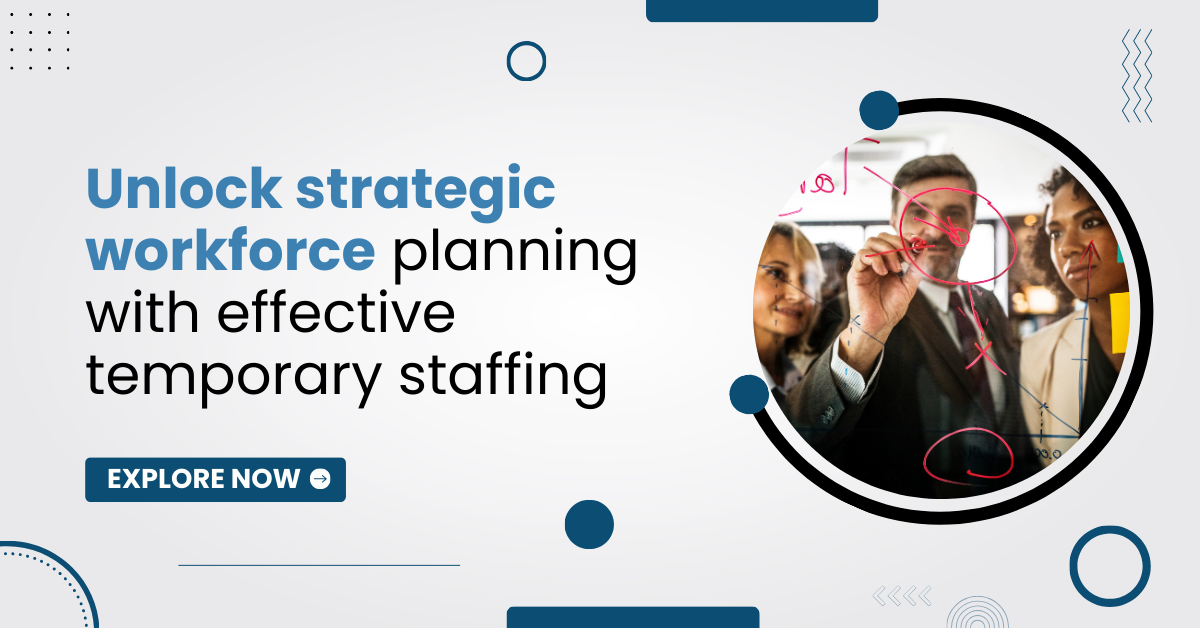The Role of Temporary Staffing in Workforce Planning
In today’s fast-paced business world, being flexible with your workforce is really important. It helps you keep up with changes and stay competitive. One great way to do this is through temporary staffing. This method lets companies quickly adjust to workload changes while keeping costs manageable. If you’re in HR, a business leader, or anyone involved in decision-making, this blog will give you some useful insights on improving your workforce planning.
What’s Temporary Staffing All About?
Temporary staffing means hiring people for a short time to fill specific roles or handle busy periods. Instead of tying yourself down with full-time employees, you can bring in temps when you need them. This setup helps businesses adapt quickly without the long-term commitments that come with permanent hires.
Why Temporary Staffing is a Smart Move
- Flexibility When You Need It
Temporary staffing lets you adjust your team size based on what’s going on. Whether it’s a busy season, a big project, or someone unexpectedly out, you can easily bring in temporary staff to keep things running smoothly.
- Cost Savings
Hiring temps can save you a lot of money. You don’t have to deal with full benefits or long-term commitments, which helps you use your budget more effectively.
- Access to Specialized Skills
Sometimes, you need someone with skills that your current team doesn’t have. Temporary staffing allows you to bring in experts for a short period without the hassle of making a permanent hire.
- Quick Hiring and Onboarding
Staffing agencies can find the right people quickly. This means less time spent on hiring and more time to focus on your business.
- Challenges with Temporary Staffing
While there are many benefits, there are also some challenges to consider:
- Blending into Company Culture
Temporary workers might find it tricky to fit in with your existing team or get a grasp on the company’s culture. This can sometimes lead to feelings of disconnect.
- Training Needs
Even though they’re temporary, you still need to train them. Getting temps up to speed can take time and resources, which might cut into your savings a bit.
- Quality Can Vary
Not every temp will be the perfect match. That’s why it’s important to work with staffing agencies that understand your needs and can find the right candidates.
Explore Our Global Talent Research and Staffing Services
Tips for Making Temporary Staffing Work
- Regularly Check Your Needs
Take some time to evaluate your team’s workload now and then. Knowing when you might need extra help makes it easier to plan ahead and bring in temps before things get too busy.
- Be Clear About Roles
Having clear job descriptions really helps. It ensures that temps know exactly what’s expected of them and helps you find the right person for the job.
- Encourage Open Communication
Make sure there’s good communication between your full-time employees and temps. Encouraging teamwork can help everyone feel more connected and reduce any misunderstandings.
- Choose the Right Staffing Agency
Picking a good staffing agency can make a big difference. They should take the time to understand your business and find temps who fit both the role and your company’s vibe.
How Infojini Can Help
At Infojini, we know that workforce needs can change in the blink of an eye. That’s why we’re here to help you find the right temporary talent just when you need it. Our team specializes in connecting businesses with skilled temps who can jump in and start contributing right away. With our support, you’ll be able to stay flexible and productive no matter what comes your way.
Conclusion
Temporary staffing is a fantastic tool for businesses that want to stay agile and handle changes smoothly. By keeping an eye on your needs, being clear about roles, and teaming up with a reliable staffing agency, you can make the most of temporary workers. As your business landscape evolves, effectively using temp staff can help you stay ahead of the game and keep everything running smoothly.
Team-Based Staffing: A Comprehensive Guide to Building and Managing Effective Teams
- What are some common challenges that organizations face when implementing team-based staffing systems?
- How can businesses benefit from using Infojini’s team-based staffing model?
- Can you provide examples of successful team-based staffing projects that Infojini has completed in the past?
Subscribe For Updates
Categories
- Accountant
- AI
- Automation
- Awards and Recognitions
- Blue Collar Staffing
- Burnouts
- Campus Recruiting
- Cloud
- Co-Ops agreements
- Company Culture
- Compliance
- contingent workforce
- Contingent Workforce
- COVID-19
- Cyber Security Staffing
- Data Strategy
- Digital Transformation
- direct sourcing
- Distributed Workforce
- Diversity
- Diversity & Inclusion
- Economy
- Events & Conferences
- fleet industry
- Gig Economy
- Girls in Tech
- Global Talent Research and Staffing
- Government
- Healthcare
- Healthcare Staffing
- Hiring Process
- Hiring Trends
- Home Helathcare
- HR
- HR Practices
- HR Tech
- IT
- Labor Shortages
- Life Science
- Local Governments
- News
- Nursing
- Payroll Staffing
- Public Sectors
- Recruiting
- Remote Work
- Skill Gap
- SMB Hiring
- Snowflake
- Staffing
- Staffing Augmentation
- Staffing Challenges
- Talent ROI
- Tech Staffing
- Technology
- Tips & tricks
- Total Talent Management
- UI/UX Design
- Uncategorized
- Veteran Staffing
- Veterans Hiring
- Veterans Hiring
- Workforce Management
Recent Posts
- Automation in Recruiting: From Chatbots to Predictive Screening
- Gig Economy Expansion: The Impact on Talent Pools and Business Models
- Skills-Based Hiring: Why Credentials Alone Don’t Cut It in 2025
- Procurement 3.0: AI & Intelligent Automation in 2025
- Q3 Is Here: Is Your Contingent Workforce Strategy Falling Behind?
Newsletter
Archive
- September 2025
- August 2025
- June 2025
- April 2025
- March 2025
- December 2024
- November 2024
- October 2024
- September 2024
- August 2024
- July 2024
- June 2024
- May 2024
- April 2024
- March 2024
- February 2024
- January 2024
- December 2023
- November 2023
- October 2023
- September 2023
- August 2023
- July 2023
- June 2023
- May 2023
- April 2023
- March 2023
- February 2023
- December 2022
- November 2022
- October 2022
- September 2022
- August 2022
- July 2022
- June 2022
- November 2021
- October 2021
- September 2021
- August 2021
- July 2021
- June 2021
- May 2021
- April 2021
- March 2021
- February 2021
- January 2021
- December 2020
- November 2020
- October 2020
- September 2020
- August 2020
- July 2020
- June 2020
- May 2020
- April 2020
- March 2020
- February 2020
- January 2020
- December 2019
- November 2019
- October 2019
- September 2019
- August 2019
- July 2019
- June 2019
- May 2019
- January 2019
- December 2018
- November 2018
- October 2018
- September 2018
- August 2018
- July 2018
- June 2018
- May 2018
- April 2018
- March 2018
- February 2018
- January 2018
- December 2017
- November 2017
- October 2017
- September 2017
- August 2017
- July 2017
- June 2017
- May 2017
- November 2016
- October 2016




